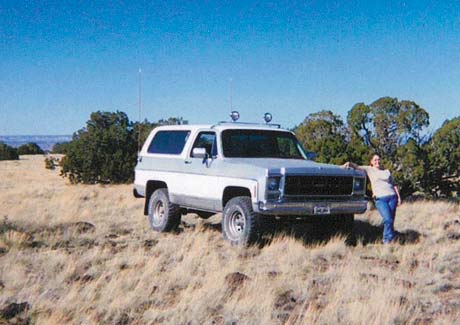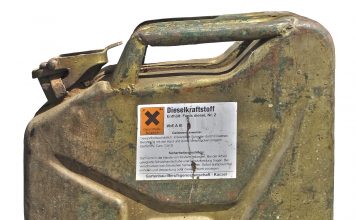| Issue #116 • March/April, 2009 |
Let’s face itwe all own vehicles. Our rural lifestyle pretty much leaves us dependent on our vehicles for all of our daily transportation needs, as well as the hauling of firewood, supplies, groceries, the kids to school, and even our potable water. And those dirt roads can be merciless on vehicles.
In the small northern Arizona town I live in now, I am a mechanic at the local garage. It has been my experience that a lot of folks won’t bat an eye at spending thousands of dollars on their solar equipment, generators, well pumps, TVs, and even ATVs, but the thought of spending any money on their vehicleand investment second only to their homesends some folks into a tantrum. Oftentimes, the tantrum occurs only after the vehicle has left them stranded in the middle of nowhere, at night while it’s raining, with groceries in the open bed of the truck.
So what can those of us who choose this lifestyle do to keep the Ol’ Gal purring like a kitten, without breaking the bank (or our backs)? You may be surprised to find out just how easy it can be to keep your vehicle running smoothly and reliably. Though it is very unlikely that you will never need the services of a repair shop, it doesn’t take much to make those visits an exception, rather than a rule. I am constantly amazed at how many folks won’t spend 20 bucks today that’ll save them $200 in a month. If you’re like me, money is tight of late, but with a little effort, and maybe some help from a friend, you can keep your money in your pocket, and your vehicle on the roadand not on the mechanic’s lift.
I’m going to skip the obvious advice like “Change your oil every 3000 miles,” and all that other stuff you can find in a pamphlet on the counter of any store in America that has anything to do with vehicles. Instead I’m going to suggest some things that are overlooked by probably 99% of the people driving today.
|
Wash me!
While a lot of folks consider it a waste of time to wash their vehicles because, “It’s just going to be dirty again in a few days,” washing your vehicle at least every other week will do wonders at keeping your tires on the road, and not six feet in the air on the mechanic’s lift. Don’t think you have go crazy on the part of the car you can see; it’s the suspension, engine, and the undercarriage that need the attention here. Nothing is more destructive to seals, gaskets, U-joints, cables, and brakes than being entombed in a layer of dirt. It’s ruining your vehicle, and some shops will even charge extra if they have to pressure wash all that dirt off of your truck, just to be able to see and get at the nuts, bolts, and screws of your rig. How can you expect to find out why you’ve been adding a quart of oil to your truck every week, when the entire engine from the air cleaner to the oil pan is one giant glob of dirt-encrusted oil?
|
Plus, poking your nose in the unfamiliar nooks and crannies of your vehicle gives you a heads up on parts that may be starting to wear, and saves on costlier repairs later on. Keeping the motor clean helps it run cooler, and a cooler motor is a happy motor.
Dirt in the steering and suspension components, and especially the brakes, grinds those pads and rotors down to the rivets in no time, in some cases actually halving the life of the brakes. Dirt crusted on the wheels causes them to become out of balance, causing uneven tire wear, a harsh ride, and bearing failure. A lot of newer 4×4 trucks don’t have the traditional bearings you may be used to. They have “Hub Assemblies,” and they are not cheap. Plan on spending close to $400, if not more, for one assembly alone (there are two), and that doesn’t include the labor to have it installed. I could go on for pages about all the bad things that not washing your vehicle can do, so just do it. Most DIY carwashes charge about $1.50 to $2.00 for five or six minutes of pressure washing time. It’s cheap insurance and money well spent.
Recreational reading
Our small towns are often blessed with at least one auto parts store. (My town, small as it is, actually has two.) Go there and pick up a repair manual for your particular vehicle. They’re usually less than 20 bucks. The most popular names in the business are Chilton’s and Haynes. I have gotten into the habit of buying one from each publisher, as oftentimes one will have information or diagrams the other does not, or explain a repair in a way that is easier to understand. I have also run across conflicting information though, as when I was repairing the transfer case on my old 4×4 truck. One book said to put 10W-40 oil in it, the other said it took automatic transmission fluid. A quick call to the local dealership, or a search of online repair forums can usually solve the problem in short order. The general rule of thumb with these manuals is “If they both say the same thing, it’s probably correct; if they don’t, find out before proceeding.”
|
Another good source of material is your vehicle’s dealership, eBay, or your local used bookstore. I’ve come across factory assembly manuals, the very books the factories publish for every vehicle to tell its workers how to build the car, for pennies. These books are the Holy Bible for vehicles, and are invaluable for their technical information, schematics, and part numbers. They tell you step-by-step how to remove, replace, or repair just about any and every part on your vehicle, and what tools you need to do it with. It’s a lot cheaper to take a part down to the garage and have a bearing pressed out, than it is to pay the shop to do the entire repair.
And don’t forget about that book you already own that you’ve probably never readthat’s right, your vehicle’s owner’s manual. Most folks throw it in the trunk or even in the trash, as it is taking up valuable glove compartment space. Pick yours up and read it. I guarantee you’ll find out something about how your vehicle works. The maintenance schedule is written in there for a reason too, not simply to get you to buy stuff you don’t need. Everyone has a guy in their neighborhood who drives an old car or truck everyday. It’s a vehicle he’s had since the day it was new, yet it looks like it’s just come out of a time machine, and runs like a top. Trust me, it doesn’t stay that way by accident.
There are also a lot of excellent websites, frequented by dealer-trained master technicians, for just about any make and model of car. They are often happy to donate their time to help you get to the root of a problem, or point out if a shop’s estimate may not be on the “up and up.” One of the best sites is http://flatratetech.com/community. You’ll be hard pressed to find a site with more knowledgeable people willing to help folks out for free.
You can never have too many friends…
You will be amazed at how valuable a friendly relationship with the parts store counter guy can be. Nothing makes a parts person want to try harder than knowing that you are his regular customer. He will bend over backwards to help you, provide invaluable advice, and probably even cut you a break on the prices every now and then. I speak from experience when I say this, as I am an ASE Certified Parts Consultant, and have always taken pride in the fact that I have a circle of customers who come to me when they need something. I make sure they walk out happy every time.
Just as having a friend in the parts business is a good thing, having a friend in the repair business is just as, if not more, valuable. Find a shop you trust and are comfortable with, and stick with them! Nothing aggravates a shop owner, service manager, or technician more than the “fair weather customer” that comes to you for some stuff, then goes to the other guy because his oil change is $2 cheaper, then goes to yet another guy for something else. You can bet your bottom dollar, especially in a small town, that eventually all the shops in town will realize that you are not loyal to one shop, and that the “bottom line” is all that matters to you. At which point you can expect no extra “fringe benefits” the regulars receive. The two or three bucks you may save today will eventually end up costing you a lot more in the long run.
|
A good example of this is the old “Check Engine Light.” My good friend and loyal customer comes in with his light on. It gets scanned, and a likely diagnosis of the problem is given. No charge, have a nice day, call me when you need it done, we’ll get it done ASAP. Later, Mr. Fairweather comes in with his light on, the car gets scanned, but we’re not sure what, exactly, is wrong with it. He’ll have to make an appointment for next week so we can spend some more time diagnosing it. It’ll be 25 bucks for scanning the vehicle today, because we know he’s just going to go somewhere else and tell them what we just told him, and act like he figured it out all by himself. Fairweather gets charged for diagnosis every time. Shop supplies every time. His vehicle will sit and wait while one of the regular’s vehicles is moved ahead of his, for a repair that takes longer than his does, on the Friday before the three-day holiday weekend when hunting season is starting, every time.
“Why?” you may ask. Because the owner or the service writer knows that the only reason he’s here is because he called every shop in the county for estimates and prices and we won the “estimate lottery” this time around. And we know that next week your rig will be at the “Other Guy’s” shop getting $1200 worth of new tires because we quoted you 10 bucks more per tire. Yes, you may pay a little more for some things, but less for others, and the money and time you save when you really need something major done will make it all worth every penny.
All of this is not a conspiracy, or a ripoff, it’s just the nature of the business. If we know you’re going to come to us with all your hard repairs, and all the easy ones too, you’re going to have the red carpet rolled out for you each time, because we know that it’s folks like you who keep the lights on and the doors open, period, plain and simple.
Your turn
Okay. Enough about what everyone else can do for you. Now that you’re back from the DIY carwash, let’s see what else you can do to keep your car running well, and save a few bucks at the same time. Just because it starts and runs every morning doesn’t mean there aren’t things that can’t be done to make it run more efficiently. In today’s world, efficient = better MPG, which translates to less $$ in the tank. The few dollars and the afternoon you spend in the garage today will pay off down the road in the form of better mileage and a more reliable vehicle you can drive every day with confidence.
Since everything is all clean now, take a few minutes to inspect the parts for signs of damage, leaks, or wear that can be replaced now, when you want to, rather than later, when you have to. Every part on every car is connected to another part or two somewhere, so if one of them isn’t working, you can guarantee that while the other two attached to it may be fine, they’re just along for the ride.
|
One of the most common culprits I see are spark plug wires. I can’t tell you how many folks come to me because their car runs rough, “But I replace the spark plugs every 25,000 miles!” Well, that’s all fine and dandy, but if you’re expecting spark plugs to fire through the original wires that the factory installed back in 1984 when the vehicle was built, think again. Grab a flashlight, and grab one of the wires, (with the engine off) and try to make a small loop with it around one of your fingers. Is it all dry, cracked, and brittle feeling? Chances are, some of these wires are grounding out into a valve cover or exhaust part, and that cylinder of the engine is now a drain on the rest, rather than pulling its own freight. If the wires have numbers printed on them indicating which cylinder they are attached to, they are more than likely the original factory wires and need to be changed. Change each wire one at a time to ensure that the right wire goes on the right plug.
I always insist on using the exact same type of plugs that the factory installed. Don’t ever believe the 99 cent “El Cheap-os” will be just as good. They’re not. Cheap plugs are designed to make weak ignition systems perform better. Gasoline wants a nice fat hot spark to light itself off with, and you should too.
While you’re at it, change the cap and rotor too. Now check the hoses, belts, fluids, and air filter while you’re in there. Be sure to check the condition of the antifreeze.
You may want to bring your vehicle to a shop and have them perform an inspection to see what they find. Usually, this can be done for a small fee or is even free at some places. It is a lot easier to spot things that need attention while the vehicle is on the rack, rather than crawling under it in the dirt. (U-joints are a good example of parts that are often overlooked. Greasing them today usually prevents having to replace them tomorrow.)
Fuel filter
Most cars and trucks with fuel injection systems built since the mid-to-late 80s have electric fuel pumps. Those pumps are usually located inside the gas tank. The days of mechanical pumps bolted to the engine with two little bolts are long gone. Now, you have to drop the whole fuel tank out and spend anywhere from 50 to 500 bucks for the new pump. (And just the pump, it’s another 2½ hours or more of labor time to have it installed.) It’s inevitable that this pump will have to be replaced some day, but if you could spend 20 bucks two or three times a year, and double or even triple the life of that pump, wouldn’t that be a wise investment? Change your fuel filter at least every 15,000 miles. Your owner’s manual may say every 30-45,000 miles, but if you’re driving along a dirt road for 10 or 15 miles every day just to get home, you would be amazed at how much dirt gets in your fuel tank.
The “check engine light”
It is called many things by different manufacturers and people. A “MIL” (malfunction indicator lamp), a “Service Engine Soon” light, or a “Trouble” light. On some vehicles, it’s even just a picture of a hand holding a wrench, or an exclamation point in a circle backlit in yellow or red. Regardless of what you call it, or what it looks like, its message is the same. Something is wrong! Yet why so many people just choose to ignore it escapes me. I’ve had people offer to pay me to disassemble their entire dashboard just to remove the bulb, rather than actually spend the money on what is causing it to come on the first place. I’ve seen people put black tape over it, and others who just had it on so long that the bulb simply burned out.
|
Even though the vehicle may seem to run the same as it did before, the light is on for a reason, and you need to find out why. Most times, it’s something easily diagnosed and repaired if the vehicle is still running OK. But let it run that way long enough, and eventually it will start flashing while you are driving, usually right before the engine dies and leaves you stuck on the side of the road.
Tire pressure
Even though Barack Obama was generally mocked for his statements about keeping your tires at the proper pressure, he happened to be 100% correct. Not only does keeping your tires inflated properly reduce their rolling resistance, thereby letting your engine propel the vehicle at any given speed with less effort (less fuel), it also keeps your tires from wearing out prematurely, and since oil is a major ingredient in the manufacturing of tires, their prices have been creeping slowly upward as of late. Especially the big, knobby all-terrain truck tires we backwoods folks tend to have on our trucks. You may not see a huge difference right away, but, if everyone did as President Obama suggested, it would make a big difference in a short period of time. Besides, air is free. Now that you’re a regular at one of your local neighborhood shops, all you have to do is pull up there, and ask one the guys to check your tire pressure every now and then.
You can pay me now, or you can pay me later
Some of you may remember this tag line from a TV commercial back in the day. It’s just as true now as it was back then. While the scope of this article was never intended to provide specific information on specific vehicles or problems, it was intended to make you more aware of your vehicle’s maintenance requirements. Take a proactive role in the care of your vehicle, rather than simply trusting a garage on blind faith, or worse yet, driving it until something breaks. You’ll kick yourself when you find out it was something that could have been prevented with a little preventive maintenance.
I realize there are probably 100 things I failed to mention here, but there are always going to be too many things and not enough time. However, if you put into action even a few of the suggestions I mentioned here, you will be well on your way towards becoming more “in tune” with your vehicle. You won’t have to get up every morning and pray the car starts so you can get to work. Will your vehicle never break down or need repairs by following this advice? No, but a few wisely-spent dollars and a little time spent educating yourself can make it so when the time comes and the services of a shop are required, you will rest easy in the knowledge that you are getting the most out of the hard-earned dollars you spend.
Oh, and by the way, change your oil every 3,000 miles. It’s the best and cheapest insurance there is.
Thanks to Sean R. Kienle for taking all the photos here, and to Jones Auto & Tire Service in St. Johns, Arizona, for letting me take pictures in their shop, without whose cooperation this article may not have come to fruition.
Len Torney is an ASE Certified Automotive Technician, Service Advisor, and Parts Specialist with more than 20 years experience in the automotive repair industry. He and his wife, Elizabeth, and two children, Nathan and Stephanie, own 40 acres in northern Arizona where they are getting ready to build their home.




















